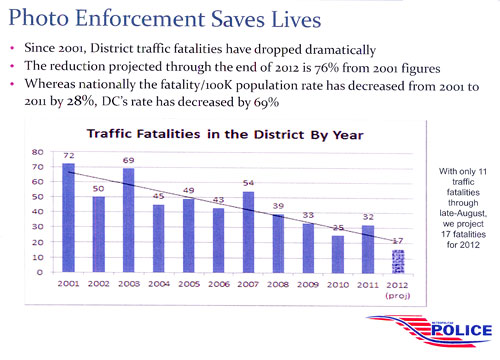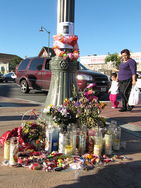Task force tries to make peace over cameras; AAA doesn’t
Traffic cameras have saved lives, said Lisa Sutter of the Metropolitan Police Department at yesterday’s task force meeting on automated enforcement. DC’s fatalities declined 69% in 10 years, compared to only 28% nationwide, and MPT believes its speed and red light cameras are the reason.
Still, many residents believe fines are too high, and that their purpose is to plug budget holes instead of make the streets safer. Will lowering the fines change that perception and increase public support for fines, or are a lot of people just unwilling to change their widespread and common behavior that’s also illegal and dangerous?
A real solution to this camera angst probably involves lower fines. It also requires driver lobbying groups to start sending more positive messages about the reasons to curb dangerous driving, instead of endlessly playing the victim in front of television cameras.
Traffic cameras work
The task force had its first meeting yesterday. I am a member of the task force, at the request of co-chairman Councilmember Mary Cheh. Sutter presented a number of slides, including this chart of traffic fatalities:

Sutter also relayed a tragic story of an elderly woman killed in a crash that one of their cameras caught on video. A driver blew through a red light and got T-boned. The crash pushed the car up onto the sidewalk, killing the woman, who wasn’t breaking any laws and wasn’t even in the street.
This is the real human toll of unsafe driving. More people died already this year, just in the District, than in the Metro Red Line crash. We can’t ignore the problem.
Can science set the fine?
The other co-chair, Tommy Wells, started off the meeting with a statement that he feels the current fines are too high, and contribute to the public perception that the cameras are a source of revenue rather than a safety tool. Cheh agreed with the goal of revising the fines, but added that they serve several purposes.
One is to simply deter people from “reckless and unsafe behavior.” Relatedly, a fine is a kind of punishment for doing something inherently dangerous, as red-light running is, she said. Ultimately, the fine needs to change a culture of lawbreaking, and sometimes a high penalty might be necessary.
Cheh and Wells asked many thoughtful and detailed questions to try to identify a proper level for a fine. Wells pointed out that it could be very helpful if photo tickets included an explanation of why the District is charging what it’s charging.
AU Professor Laura Langbein suggested an analysis which would estimate the economic and actuarial cost of the typical crash, then divide that by the chance any individual speeding or red light running would end in a crash, to get an optimal fine. That would peg a fine to the damage the behavior causes. Another approach would be to set the level around what it takes to get people to comply, but it may be hard to determine that scientifically other than through experimentation.
Where is AAA?
The task force included a representative from regional towing-services company AAA Mid-Atlantic, John Townsend. Unfortunately, he seemed little interested in any real meeting of the minds. He didn’t even participate in the first half of the meeting, when people were mainly asking questions to MPD and DDOT about the current program. Instead, he left the table for a while to go talk to the press and get himself into news stories on the issue.
Later, Townsend criticized DC’s plans to add cameras to catch people who blow through stop signs or recklessly turn across crosswalks where people on foot are crossing. These are serious safety issues in neighborhoods. If cameras can curb unsafe driving as much as they have for speeding and red light running, it can save lives and boost the quality of life in neighborhoods.
DC will only have 2-3 per ward of each type in the coming year, and I’d like to see any bill in the Council around fines also give MPD authority to buy more cameras with some of the money they raise from existing ones.
I also recommended that we discuss how to curb speeding under 10 mph over the limit. When a neighborhood limit is 30, most drivers assume that really means 40. 40 can be a dangerous speed in residential areas. MPD’s Lisa Sutter confirmed that while DC law allows MPD to ticket people for speeding less than 10 mph, they are not currently doing that with the automated cameras.
Some cities are lowering the limits to 20 in order to get drivers to stay under 30, but is that the best approach? A $75 ticket for going 32 in a 30 would be grossly unfair, but how about a $5 ticket for going 5 mph over? Or how about a $1 ticket? Can a small “nudge” change the culture from 30-means-40 to 30-means-30?
That also might mean raising some speed limits, if transportation departments have set limits artificially low. James Cheeks from DDOT said that they never set speed limits 10 mph too low because of this, but many commenters believe that at least some jurisdictions do.
Unfortunately, Townsend immediately jumped in to call the idea of any enforcement below 10 mph over the limit “a non-starter.” It sounds like he came to the meeting expecting that the only outcome would be to give drivers more of a pass for unsafe behavior.
I agree fines can come down as the number of cameras increases. However, it’s not appropriate simply to cater to the whining and lower the fines unilaterally. Will lower fines actually make drivers believe the fines are for safety instead of revenue?
Many speeders will take their cue from their chief enabler, Townsend. He can set an example by agreeing to stop the constant camera complaints if fines come down. He says AAA doesn’t condone breaking traffic laws or unsafe driving. Will he start being constructive, or is his real goal just to get attention and feed the egos of those who don’t want to change their dangerous behavior?

